Repeated Drop-Weight Impact Testing of Fibrous Concrete: State-Of-The-Art Literature Review, Analysis of Results Variation and Test Improvement Suggestions
Abstract
:1. Introduction
2. Research Significance
3. Previous Literature on the Statistical Evaluation of ACI 544-2R Impact Results
3.1. Normal Distribution
3.2. Weibull Distribution
| Reference | Concrete Type | Number of Specimens Tested per Mix | Fiber Type | Fiber Content | Compressive Strength (MPa) | COV (%) | Statistical Technique |
|---|---|---|---|---|---|---|---|
| Soroushian et al. 1992 [34] | Carbon-fiber-reinforced cement composites | 30 (two patches of 15) | CF | 2% | 28.6 | 36.3–54.6% | Normal probability |
| Nataraja et a. 1999 [32] | Steel-fiber-reinforced concrete | 15 | SF | 0.5% | 29.4–36 | 46–57.3% | Normal probability |
| Song et al. 2005 [39] | Hybrid steel-PP-fiber-reinforced concrete | 48 | SF, PP | 0.5% SF 0.1% PP | 24.2–25.6 | 41–59% | Normal probability and Kolmogorov–Smirnov test |
| Song et al. 2005 [29] | High-strength fiber-reinforced concrete | 48 | SF | 1% | 66–76 | 41–44% | Normal probability and Kolmogorov–Smirnov test |
| Badr et al. 2006 [35] | PP-fiber-reinforced concrete | 20 | PP | 3 kg/m3 | 41.3 | 48.7–61.4% | Normal probability |
| Rahmani et al. 2012 [36] | Plain concrete, fiber-reinforced concrete | 32 | CE, PP, SF | 0.15, 0.15, 0.5% | 41.9–43.2 | 39–65% | Normal probability, Kolmogorov–Smirnov and Kruskal–Wallis test |
| Mastali et al. 2016 [45] | Glass-fiber-reinforced polymer self-compacting concrete | 4 (plain concrete) and 40 for fibrous mixtures | GFRP | 0.25, 0.75, 1.25% | 50.2–59.2 | 36.8–43.9% | Normal probability and Kolmogorov–Smirnov test |
| Fakharifar et al. 2014 [48] | High-performance fiber-reinforced cementitious composites | 40 | PP | 0.5–1.0% | 46.1–55.3 | 40–47% | Normal probability, Kolmogorov–Smirnov. Ryan–Joiner and Anderson–Darling tests. |
| Murali et al. 2018 [49] | Green, high-performance fiber-reinforced concrete | 40 | SF | 0.5 | - | 39–48% | Normal probability and Kolmogorov–Smirnov test |
| Mohammadhosseini et al. 2018 [57] | Fiber-reinforced concrete | 3 | WMPF | 0–1.25% | Different ages | - | Normal probability and Kolmogorov–Smirnov test |
| Jabir et al. 2020 [51] | Hybrid-fiber-reinforced reactive powder concrete | 12 | SF, PP | 2.5% | 75.2–82.8 | 36–49% | Normal probability |
| Abid et al. 2020 [69] | Steel-fiber-reinforced high-performance concrete | 15 | SF | 2.5% | 81.7 | 21.2–57.8% | Normal probability |
| Chen et al. 2011 [70] | Steel-fiber-reinforced concrete | 6 | SF | 0.5% | 66.1–67.3 | 23–75% | Two-parameter Weibull distribution |
| Ali et al. 2017 [54] | Engineered cementitious composite | 3 | PVA and SMA | (0, 2.0% PVA) (0.5, 1.0, 1.5% SMA) | - | - | Two-parameter Weibull distribution |
| Abirami et al. 2019 [37] | Multi-layered grouted fiber-reinforced concrete, Slurry infiltrated fibrous concrete | 6 | SF | 1–10% | 34.2–61.8 | - | Two-parameter Weibull distribution |
| Asrani et al., 2019 [40] | Hybrid fibrous geopolymer composites | 5 | SF, PP, GF | 0.3–1.6% | 62.4–84.6 | 14.9–50.8% | Two-parameter Weibull distribution |
| Murali et al., 2019 [71] | Two-stage fiber-reinforced concrete | 15 | SF | 1.5–5.0% | 33.3–51.3 | 9–53% | Two-parameter Weibull distribution |
| Jabir et al. 2020 [52] | High-performance fiber-reinforced concrete | 12 | SF, PP | 2.5% | 75.2–82.8 | 35.7–48.8% | Two-parameter Weibull distribution |
| Murali et al. 2020 [58] | Multi-layered preplaced aggregate fibrous concrete | 6 | SF | 2.5% | 33.3–48.5 | 16.8–46.2% | Two-parameter Weibull distribution |
| Haridharan et al. 2020 [62] | Multi-layered grouted fiber-reinforced concrete | 6 | SF | 0, 3% | 32.4–54.7 | 17–66% | Two-parameter Weibull distribution |
| Prasad and Murali 2021 [63] | Preplaced aggregate fibrous concrete | 15 | SF, PP | 2.4% | 31.6–50.3 | - | Two-parameter Weibull distribution |
4. Evaluation of Statistical Variation of the ACI 544-2R Repeated Impact Test
5. Suggested Modifications to the ACI 544-2R Repeated Impact Test
5.1. Previous Literature Works
5.2. Discussion of Scattering of Results and the Literature Suggestions
6. Conclusions
- Although several available test procedures can evaluate the material and structural performance of concrete under impact loads, the ACI 544-2R repeated impact procedure is the simplest to perform and the one that requires the lowest cost and efforts, where no sophisticated data acquisition system and sensors are required to record the force, vibration, deflection, strain or other physical parameters. Instead, only the number of repeated impact blows needed to cause the cracking and failure of the test specimens are required.
- The main disadvantage of the ACI 544-2R repeated impact test is the high scattering of the test results, where for a batch of specimens, COV values of 30 to 50% are frequent in the cracking and failure stages. The high result scattering is a source of discomfort for engineers who need experimental test results to make their decisions, which reduces the reliability of the current test procedure, where the number of test replications required to afford 90% reliability with 10% acceptable error increases with the increase in COV reaching more than 30 replications.
- Most of the reviewed literature showed that the repeated impact test results do not agree with the normal distribution or barely follow the normal distribution. On the other hand, the two-parameter Weibull distribution was reported by many previous researchers as a good statistical tool to analyze the high result dispersion of the ACI 544-2R repeated impact test.
- The statistical analysis of the available literature test results revealed that most of the mixture parameters have no significant effect on the degree of scattering of the results of the ACI 544-2R repeated impact test. The coefficient of determinations of COV with compressive strength, binder content, aggregate content, aggregate maximum size, water–binder ratio, fiber length and number of specimens were in general less than 0.5, which explicitly reveals that there is no correlation between these factors and the scattering of results. However, it was noticed that a weak correlation (R2 = 0.615) showed a tendency of COV to decrease with the increase in fiber content in the mixture.
- Badr and Ashour [73] identified five sources that cause the high scattering of the results of the ACI 544-2R repeated impact test. These sources can be summarized as: (i) cracks are allowed to occur along any direction, which makes the (ii) definition of accepted failure not suitable, and leads to the (iii) absence of a specific criterion to accept or reject the failed specimens, and (iv) the application of the load on a single central point and (v) the surface treatment of the specimens (cast and toweled or cut) are other result-scattering sources.
- Badr and Ashour [73] suggested using specimens with triangular edge notches to encourage cracking and hence failure across a specific path along the opposite notches, which could make it easier to define a criterion for accepting the failed specimens. The standard single impact point through the steel ball was replaced by a 50 mm length central line load, which also helped to specify the cracking path. To overcome the defined sources of result scattering, Abid et al. [69] suggested using a 3 mm wide and 5 mm deep surface diagonal notch to specify the cracking and failure path. To ensure that cracking would only occur along the specified path, the surface steel ball was replaced by a knife-like load-transferring plate, while soft sand bedding was suggested to be used beneath the specimens instead of the stiff steel plate to relieve the stress concentration.
- Badr and Ashour [73] reported that the COV of the impact results was reduced by approximately 30% when the suggested modified procedure was adopted instead of the standard ACI 544-2R procedure, while Abid et al. [69] revealed that the best of the suggested cases was the use of a surface line notch with sand bedding, which led to a significant reduction in the COV by approximately 60% compared to the ACI 544-2R standard procedure. Subsequent researchers confirmed the reduction in the scattering of results when using the suggested test setups of Badr and Ashour and Abid et al.
Author Contributions
Funding
Institutional Review Board Statement
Informed Consent Statement
Data Availability Statement
Conflicts of Interest
References
- Nili, M.; Afroughsabet, V. Combined effect of silica fume and steel fibers on the impact resistance and mechanical properties of concrete. Int. J. Impact Eng. 2010, 37, 879–886. [Google Scholar] [CrossRef] [Green Version]
- Zhang, W.; Chen, S.; Zhang, N.; Zhou, Y. Low-velocity flexural impact response of steel fiber reinforced concrete subjected to freeze-thaw cycles in NaCl solution. Constr. Build. Mater. 2015, 101, 522–526. [Google Scholar] [CrossRef]
- Salaimanimagudam, M.P.; Suribabu, C.R.; Murali, G.; Abid, S.R. Impact response of hammerhead pier fibrous concrete beams designed with topology optimization. Period. Polytech. Civ. Eng. 2020, 64, 1244–1258. [Google Scholar] [CrossRef]
- Zhang, W.; Chen, S.; Liu, Y. Effect of weight and drop height of hammer on the flexural impact performance of fiber-reinforced concrete. Constr. Build. Mater. 2017, 140, 31–35. [Google Scholar] [CrossRef]
- Pan, Y.; Wu, C.; Cheng, X.; Li, V.C.; He, L. Impact fatigue behaviour of GFRP mesh reinforced engineered cementitious composites for runway pavement. Constr. Build. Mater. 2020, 230, 116898. [Google Scholar] [CrossRef]
- Wang, W.; Chouw, N. The behaviour of coconut fibre reinforced concrete (CFRC) under impact loading. Constr. Build. Mater. 2017, 134, 452–461. [Google Scholar] [CrossRef]
- Murali, G.; Ramprasad, K. A feasibility of enhancing the impact strength of novel layered two stage fibrous concrete slabs. Eng. Struct. 2018, 175, 41–49. [Google Scholar] [CrossRef]
- Foglar, M.; Hajek, R.; Fladr, J.; Pachman, J.; Stoller, J. Full-scale experimental testing of the blast resistance of HPFRC and UHPFRC bridge decks. Constr. Build. Mater. 2017, 145, 588–601. [Google Scholar] [CrossRef]
- Yoo, D.Y.; Banthia, N. Mechanical and structural behaviors of ultra-high-performance fiber-reinforced concrete subjected to impact and blast. Constr. Build. Mater. 2017, 149, 416–431. [Google Scholar] [CrossRef]
- Xu, S.; Wu, P.; Li, Q.; Zhou, F.; Chen, B. Experimental investigation and numerical simulation on the blast resistance of reactive powder concrete subjected to blast by embedded explosive. Cem. Concr. Compos. 2021, 119, 103989. [Google Scholar] [CrossRef]
- Sun, D.; Xu, Y.; Wang, P.; Zhou, J.; Jin, F.; Li, H.; Fan, H. Blast responses of carbon-fiber reinforced polymer tubular columns filled with seawater sea-sand concrete. Compos. Struct. 2021, 278, 114692. [Google Scholar] [CrossRef]
- Abada, M.; Ibrahim, A.; Jung, S.J. Improving Blast Performance of Reinforced Concrete Panels Using Sacrificial Cladding with Hybrid-Multi Cell Tubes. Modelling 2021, 2, 149–165. [Google Scholar] [CrossRef]
- Feng, J.; Gao, X.; Li, J.; Dong, H.; He, Q.; Liang, J.; Sun, W. Penetration resistance of hybrid-fiber-reinforced high-strength concrete under projectile multi-impact. Constr. Build. Mater. 2019, 202, 341–352. [Google Scholar] [CrossRef]
- Mina, A.L.; Petrou, M.F.; Trezos, K.G. Resistance of an optimized ultra-high performance fiber reinforced concrete to projectile impact. Buildings 2021, 11, 63. [Google Scholar] [CrossRef]
- Murali, G.; Abid, S.R.; Abdelgader, H.S.; Amran, Y.H.M.; Shekarchi, M.; Wilde, K. Repeated Projectile Impact Tests on Multi-Layered Fibrous Cementitious Composites. Int. J. Civ. Eng. 2021, 19, 635–651. [Google Scholar] [CrossRef]
- Prasad, N.; Murali, G.; Abid, S.R.; Vatin, N.; Fediuk, R.; Amran, M. Effect of Needle Type, Number of Layers on FPAFC Composite against Low-Velocity Projectile Impact. Buildings 2021, 11, 668. [Google Scholar] [CrossRef]
- Liu, J.; Li, J.; Fang, J.; Su, Y.; Wu, C. Ultra-high performance concrete targets against high velocity projectile impact—A-state-of-the-art review. Int. J. Impact Eng. 2022, 160, 104080. [Google Scholar] [CrossRef]
- Lee, M.; Park, G.K.; Kim, S.W.; Kwak, H.G. Damage characteristics of high performance fiber-reinforced cement composites panels subjected to projectile impact. Int. J. Mech. Sci. 2022, 214, 106919. [Google Scholar] [CrossRef]
- ACI 544.2R-89; Measurement of Properties of Fiber Reinforced Concrete. American Concrete Institute: Farmington Hills, MI, USA, 1999; Volume 89, pp. 1–12.
- Yu, R.; Van Beers, L.; Spiesz, P.; Brouwers, H.J.H. Impact resistance of a sustainable Ultra-High Performance Fibre Reinforced Concrete (UHPFRC) under pendulum impact loadings. Constr. Build. Mater. 2016, 107, 203–215. [Google Scholar] [CrossRef]
- Ziada, M.; Erdem, S.; Tammam, Y.; Kara, S.; Lezcano, R.A.G. The effect of basalt fiber on mechanical, microstructural, and high-temperature properties of fly ash-based and basalt powder waste-filled sustainable geopolymer mortar. Sustainability 2021, 13, 12610. [Google Scholar] [CrossRef]
- Saleem, M.A.; Saleem, M.M.; Ahmad, Z.; Hayat, S. Predicting compressive strength of concrete using impact modulus of toughness. Case Stud. Constr. Mater. 2021, 14, e00518. [Google Scholar] [CrossRef]
- Ashraf, M.R.; Akmal, U.; Khurram, N.; Aslam, F.; Deifalla, A.F. Impact Resistance of Styrene–Butadiene Rubber (SBR) Latex-Modified Fiber-Reinforced Concrete: The Role of Aggregate Size. Materials 2022, 15, 1283. [Google Scholar] [CrossRef] [PubMed]
- Batran, T.Z.; Ismail, M.K.; Hassan, A.A.A. Behavior of novel hybrid lightweight concrete composites under drop-weight impact loading. Structures 2021, 34, 2789–2800. [Google Scholar] [CrossRef]
- Huang, Z.; Chen, W.; Tran, T.T.; Pham, T.M.; Hao, H.; Chen, Z.; Elchalakani, M. Experimental and numerical study on concrete beams reinforced with Basalt FRP bars under static and impact loads. Compos. Struct. 2021, 263, 113648. [Google Scholar] [CrossRef]
- Yılmaz, T.; Anil, Ö.; Erdem, R.T. Experimental and numerical investigation of impact behavior of RC slab with different opening size and layout. Structures 2022, 35, 818–832. [Google Scholar] [CrossRef]
- Said, A.M.I.; Mouwainea, E.M. Experimental investigation on reinforced concrete slabs under high-mass low velocity repeated impact loads. Structures 2022, 35, 314–324. [Google Scholar] [CrossRef]
- Schrader, E.K. Impact Resistance and Test Procedure for Concrete. J. Am. Concr. Inst. 1981, 78, 141–146. [Google Scholar] [CrossRef]
- Song, P.S.; Wu, J.C.; Hwang, S.; Sheu, B.C. Assessment of statistical variations in impact resistance of high-strength concrete and high-strength steel fiber-reinforced concrete. Cem. Concr. Res. 2005, 35, 393–399. [Google Scholar] [CrossRef]
- Nia, A.A.; Hedayatian, M.; Nili, M.; Sabet, V.A. An experimental and numerical study on how steel and polypropylene fibers affect the impact resistance in fiber-reinforced concrete. Int. J. Impact Eng. 2012, 46, 62–73. [Google Scholar] [CrossRef]
- Abid, S.R.; Ali, S.H.; Goaiz, H.A.; Al-Gasham, T.S.; Kadhim, A.L. Impact resistance of steel fiber-reinforced self-compacting concrete. Mag. Civ. Eng. 2021, 105, 2712–8172. [Google Scholar] [CrossRef]
- Nataraja, M.C.; Dhang, N.; Gupta, A.P. Statistical variations in impact resistance of steel fiber-reinforced concrete subjected to drop weight test. Cem. Concr. Res. 1999, 29, 989–995. [Google Scholar] [CrossRef]
- Nili, M.; Afroughsabet, V. The effects of silica fume and polypropylene fibers on the impact resistance and mechanical properties of concrete. Constr. Build. Mater. 2010, 24, 927–933. [Google Scholar] [CrossRef]
- Soroushian, P.; Nagi, M.; Alhozaimy, A. Statistical variations in the mechanical properties of carbon fiber reinforced cement composites. ACI Mater. J. 1992, 89, 131–138. [Google Scholar] [CrossRef]
- Badr, A.; Ashour, A.F.; Platten, A.K. Statistical variations in impact resistance of polypropylene fibre-reinforced concrete. Int. J. Impact Eng. 2006, 32, 1907–1920. [Google Scholar] [CrossRef] [Green Version]
- Rahmani, T.; Kiani, B.; Shekarchi, M.; Safari, A. Statistical and experimental analysis on the behavior of fiber reinforced concretes subjected to drop weight test. Constr. Build. Mater. 2012, 37, 360–369. [Google Scholar] [CrossRef]
- Abirami, T.; Loganaganandan, M.; Murali, G.; Fediuk, R.; Sreekrishna, R.V.; Vignesh, T.; Januppriya, G.; Karthikeyan, K. Experimental research on impact response of novel steel fibrous concretes under falling mass impact. Constr. Build. Mater. 2019, 222, 447–457. [Google Scholar] [CrossRef]
- Yildirim, S.T.; Ekinci, C.E.; Findik, F. Properties of Hybrid Fiber Reinforced Concrete under Repeated Impact Loads 1. Russ. J. Nondestruct. Test. 2010, 46, 538–546. [Google Scholar] [CrossRef]
- Song, P.S.; Wu, J.C.; Hwang, S.; Sheu, B.C. Statistical analysis of impact strength and strength reliability of steel-polypropylene hybrid fiber-reinforced concrete. Constr. Build. Mater. 2005, 19, 1–9. [Google Scholar] [CrossRef]
- Asrani, N.P.; Murali, G.; Parthiban, K.; Surya, K.; Prakash, A.; Rathika, K.; Chandru, U. A feasibility of enhancing the impact resistance of hybrid fibrous geopolymer composites: Experiments and modelling. Constr. Build. Mater. 2019, 203, 56–68. [Google Scholar] [CrossRef]
- Khalil, E.; Abd-Elmohsen, M.; Anwar, A.M. Impact Resistance of Rubberized Self-Compacting Concrete. Water Sci. 2015, 29, 45–53. [Google Scholar] [CrossRef] [Green Version]
- Mastali, M.; Dalvand, A. The impact resistance and mechanical properties of self-compacting concrete reinforced with recycled CFRP pieces. Compos. Part B Eng. 2016, 92, 360–376. [Google Scholar] [CrossRef]
- Mastali, M.; Dalvand, A.; Sattarifard, A. The impact resistance and mechanical properties of the reinforced self-compacting concrete incorporating recycled CFRP fiber with different lengths and dosages. Compos. Part B Eng. 2017, 112, 74–92. [Google Scholar] [CrossRef]
- Ismail, M.K.; Hassan, A.A.A. Impact Resistance and Mechanical Properties of Self-Consolidating Rubberized Concrete Reinforced with Steel Fibers. J. Mater. Civ. Eng. 2017, 29, 04016193. [Google Scholar] [CrossRef]
- Mastali, M.; Dalvand, A.; Sattarifard, A.R. The impact resistance and mechanical properties of reinforced self-compacting concrete with recycled glass fibre reinforced polymers. J. Clean. Prod. 2016, 124, 312–324. [Google Scholar] [CrossRef]
- Abid, S.R.; Gunasekaran, M.; Ali, S.H.; Kadhum, A.L.; Al-Gasham, T.S.; Fediuk, R.; Vatin, N.; Karelina, M. Impact performance of steel fiber-reinforced self-compacting concrete against repeated drop weight impact. Crystals 2021, 11, 91. [Google Scholar] [CrossRef]
- Abid, S.R.; Abdul-Hussein, M.L.; Ayoob, N.S.; Ali, S.H.; Kadhum, A.L. Repeated drop-weight impact tests on self-compacting concrete reinforced with micro-steel fiber. Heliyon 2020, 6, e03198. [Google Scholar] [CrossRef] [Green Version]
- Fakharifar, M.; Dalvand, A.; Arezoumandi, M.; Sharbatdar, M.K.; Chen, G.; Kheyroddin, A. Mechanical properties of high performance fiber reinforced cementitious composites. Comput. Chem. Eng. 2014, 71, 510–520. [Google Scholar] [CrossRef]
- Murali, G.; Prasad, N.; Klyuev, S.; Fediuk, R.; Abid, S.R.; Amran, M.; Vatin, N. Impact resistance of functionally layered two-stage fibrous concrete. Fibers 2021, 9, 88. [Google Scholar] [CrossRef]
- Gunasekaran, M.; Kothandapani, K.; Kanthamani, M.K.H. Statistical scrutiny of variations in impact strength of green high performance fibre reinforced concrete subjected to drop weight test. Rom. J. Mater. 2018, 48, 214–221. [Google Scholar]
- Jabir, H.A.; Abid, S.R.; Hussein, M.L.A.; Ali, S.H. Repeated Drop-Weight Impact Tests on RPC Containing Hybrid Fibers. Appl. Mech. Mater. 2020, 897, 49–55. [Google Scholar] [CrossRef]
- Jabir, H.A.; Abid, S.R.; Murali, G.; Ali, S.H.; Klyuev, S.; Fediuk, R.; Vatin, N.; Promakhov, V.; Vasilev, Y. Experimental tests and reliability analysis of the cracking impact resistance of uhpfrc. Fibers 2020, 8, 74. [Google Scholar] [CrossRef]
- Ismail, M.K.; Hassan, A.A.A.; Lachemi, M. Performance of Self-Consolidating Engineered Cementitious Composite under Drop-Weight Impact Loading. J. Mater. Civ. Eng. 2019, 31, 04018400. [Google Scholar] [CrossRef]
- Ali, M.A.E.M.; Soliman, A.M.; Nehdi, M.L. Hybrid-fiber reinforced engineered cementitious composite under tensile and impact loading. Mater. Des. 2017, 117, 139–149. [Google Scholar] [CrossRef]
- Al-Ameri, R.A.; Abid, S.R.; Murali, G.; Ali, S.H.; Özakça, M.; Vatin, N.I. Residual Impact Performance of ECC Subjected to Sub-High Temperatures. Materials 2022, 15, 454. [Google Scholar] [CrossRef] [PubMed]
- Al-Ameri, R.A.; Abid, S.R.; Özakça, M. Mechanical and Impact Properties of Engineered Cementitious Composites Reinforced with PP Fibers at Elevated Temperatures. Fire 2022, 5, 3. [Google Scholar] [CrossRef]
- Mohammadhosseini, H.; Alrshoudi, F.; Tahir, M.M.; Alyousef, R.; Alghamdi, H.; Alharbi, Y.R.; Alsaif, A. Performance evaluation of novel prepacked aggregate concrete reinforced with waste polypropylene fibers at elevated temperatures. Constr. Build. Mater. 2020, 259, 120418. [Google Scholar] [CrossRef]
- Murali, G.; Abid, S.R.; Amran, Y.H.M.; Abdelgader, H.S.; Fediuk, R.; Susrutha, A.; Poonguzhali, K. Impact performance of novel multi-layered prepacked aggregate fibrous composites under compression and bending. Structures 2020, 28, 1502–1515. [Google Scholar] [CrossRef]
- Murali, G.; Prasad, N.; Abid, S.R.; Vatin, N.I. Response of Functionally Graded Preplaced Aggregate Fibrous Concrete with Superior Impact Strength. Buildings 2022, 12, 563. [Google Scholar] [CrossRef]
- Vatin, N.I.; Murali, G.; Abid, S.R.; de Azevedo, A.R.G.; Tayeh, B.; Dixit, S. Enhancing the Impact Strength of Prepacked Aggregate Fibrous Concrete Using Asphalt-Coated Aggregates. Materials 2022, 15, 2598. [Google Scholar] [CrossRef]
- Murali, G.; Abid, S.R.; Amran, M.; Vatin, N.I.; Fediuk, R. DropWeight Impact Test on Prepacked Aggregate Fibrous Concrete—An Experimental Study. Materials 2022, 15, 3096. [Google Scholar] [CrossRef]
- Haridharan, M.K.; Matheswaran, S.; Murali, G.; Abid, S.R.; Fediuk, R.; Amran, Y.H.M.; Abdelgader, H.S. Impact response of two-layered grouted aggregate fibrous concrete composite under falling mass impact. Constr. Build. Mater. 2020, 263, 120628. [Google Scholar] [CrossRef]
- Prasad, N.; Murali, G. Exploring the impact performance of functionally-graded preplaced aggregate concrete incorporating steel and polypropylene fibres. J. Build. Eng. 2021, 35, 102077. [Google Scholar] [CrossRef]
- AbdelAleem, B.H.; Ismail, M.K.; Hassan, A.A.A. The combined effect of crumb rubber and synthetic fibers on impact resistance of self-consolidating concrete. Constr. Build. Mater. 2018, 162, 816–829. [Google Scholar] [CrossRef]
- Kathirvel, P.; Murali, G.; Vatin, N.I.; Abid, S.R. Experimental Study on Self Compacting Fibrous Concrete Comprising Magnesium Sulphate Solution Treated Recycled Aggregates. Materials 2022, 15, 340. [Google Scholar] [CrossRef] [PubMed]
- Murali, G.; Abid, S.R.; Amran, M.; Fediuk, R.; Vatin, N.; Karelina, M. Combined effect of multi-walled carbon nanotubes, steel fibre and glass fibre mesh on novel two-stage expanded clay aggregate concrete against impact loading. Crystals 2021, 11, 720. [Google Scholar] [CrossRef]
- Murali, G.; Abid, S.R.; Karthikeyan, K.; Haridharan, M.K.; Amran, M.; Siva, A. Low-velocity impact response of novel prepacked expanded clay aggregate fibrous concrete produced with carbon nano tube, glass fiber mesh and steel fiber. Constr. Build. Mater. 2021, 284, 122749. [Google Scholar] [CrossRef]
- Karthik, S.; Mohan, K.S.R.; Murali, G. Investigations on the Response of Novel Layered Geopolymer Fibrous Concrete to Drop Weight Impact. Buildings 2022, 12, 100. [Google Scholar] [CrossRef]
- Abid, S.R.; Hussein, M.L.A.; Ali, S.H.; Kazem, A.F. Suggested modified testing techniques to the ACI 544-R repeated drop-weight impact test. Constr. Build. Mater. 2020, 244, 118321. [Google Scholar] [CrossRef]
- Chen, X.Y.; Ding, Y.N.; Azevedo, C. Combined effect of steel fibres and steel rebars on impact resistance of high performance concrete. J. Cent. South Univ. Technol. 2011, 18, 1677–1684. [Google Scholar] [CrossRef] [Green Version]
- Murali, G.; Asrani, N.P.; Ramkumar, V.R.; Siva, A.; Haridharan, M.K. Impact Resistance and Strength Reliability of Novel Two-Stage Fibre-Reinforced Concrete. Arab. J. Sci. Eng. 2019, 44, 4477–4490. [Google Scholar] [CrossRef]
- Al-ameri, R.A.; Abid, S.R.; Murali, G.; Ali, S.H.; Özakça, M. Residual repeated impact strength of concrete exposed to elevated temperatures. Crystals 2021, 11, 941. [Google Scholar] [CrossRef]
- Badr, A.; Ashour, A.F. Modified ACI drop-weight impact test for concrete. ACI Mater. J. 2005, 102, 249–255. [Google Scholar] [CrossRef] [Green Version]
- Zhu, X.C.; Zhu, H.; Li, H.R. Drop-weight impact test on U-shape concrete specimens with statistical and regression analyses. Materials 2015, 8, 5877–5890. [Google Scholar] [CrossRef] [PubMed] [Green Version]
- Haruna, S.I.; Zhu, H.; Jiang, W.; Shao, J. Evaluation of impact resistance properties of polyurethane-based polymer concrete for the repair of runway subjected to repeated drop-weight impact test. Constr. Build. Mater. 2021, 309, 125152. [Google Scholar] [CrossRef]
- Ramakrishnan, K.; Depak, S.R.; Hariharan, K.R.; Abid, S.R.; Murali, G.; Cecchin, D.; Fediuk, R.; Amran, Y.H.M.; Abdelgader, H.S.; Khatib, J.M. Standard and modified falling mass impact tests on preplaced aggregate fibrous concrete and slurry infiltrated fibrous concrete. Constr. Build. Mater. 2021, 298, 123857. [Google Scholar] [CrossRef]
- Myers, J.J.; Tinsley, M. Impact resistance of blast mitigation material using modified aci drop-weight impact test. ACI Mater. J. 2013, 110, 339–348. [Google Scholar] [CrossRef]
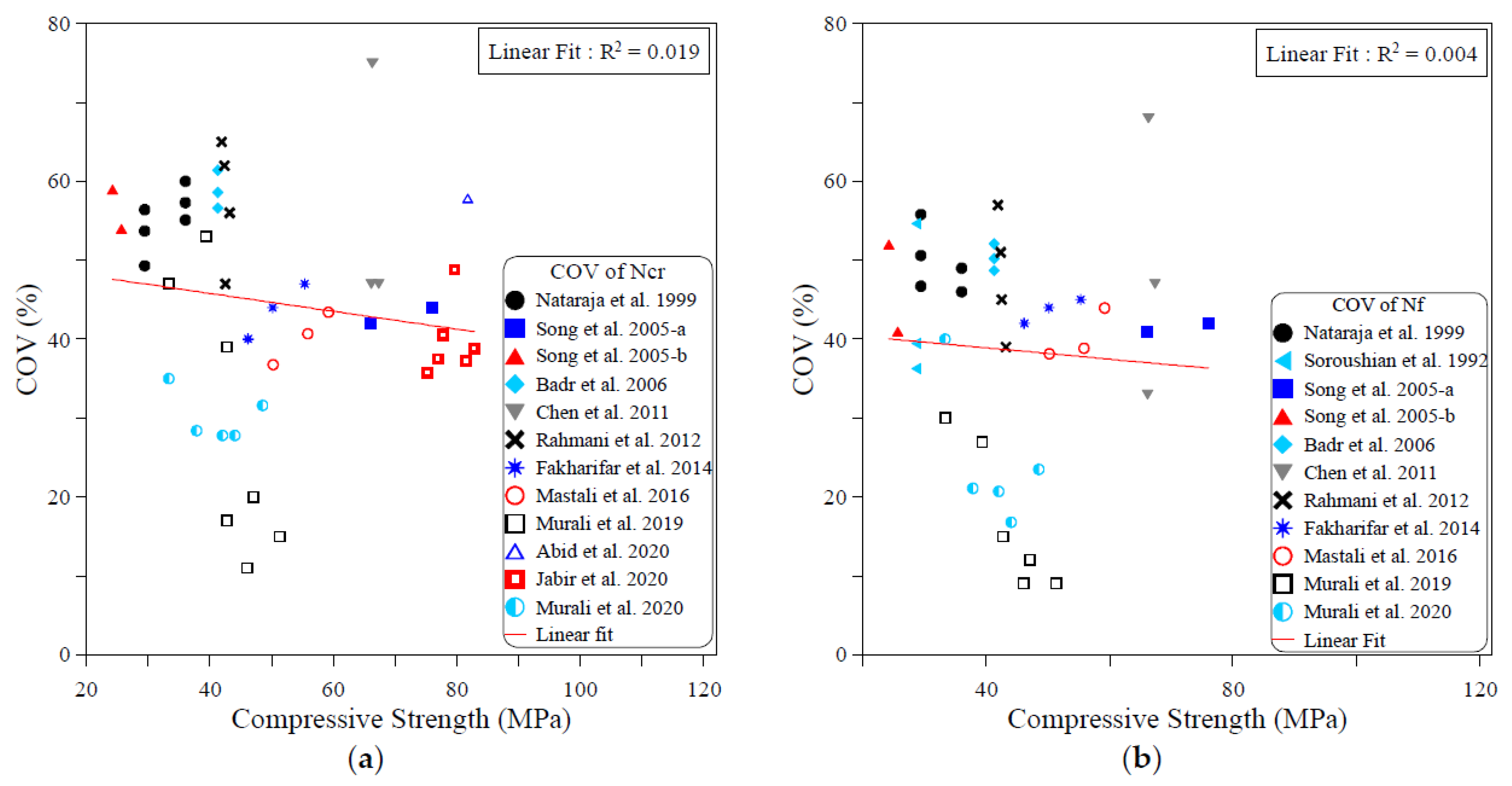
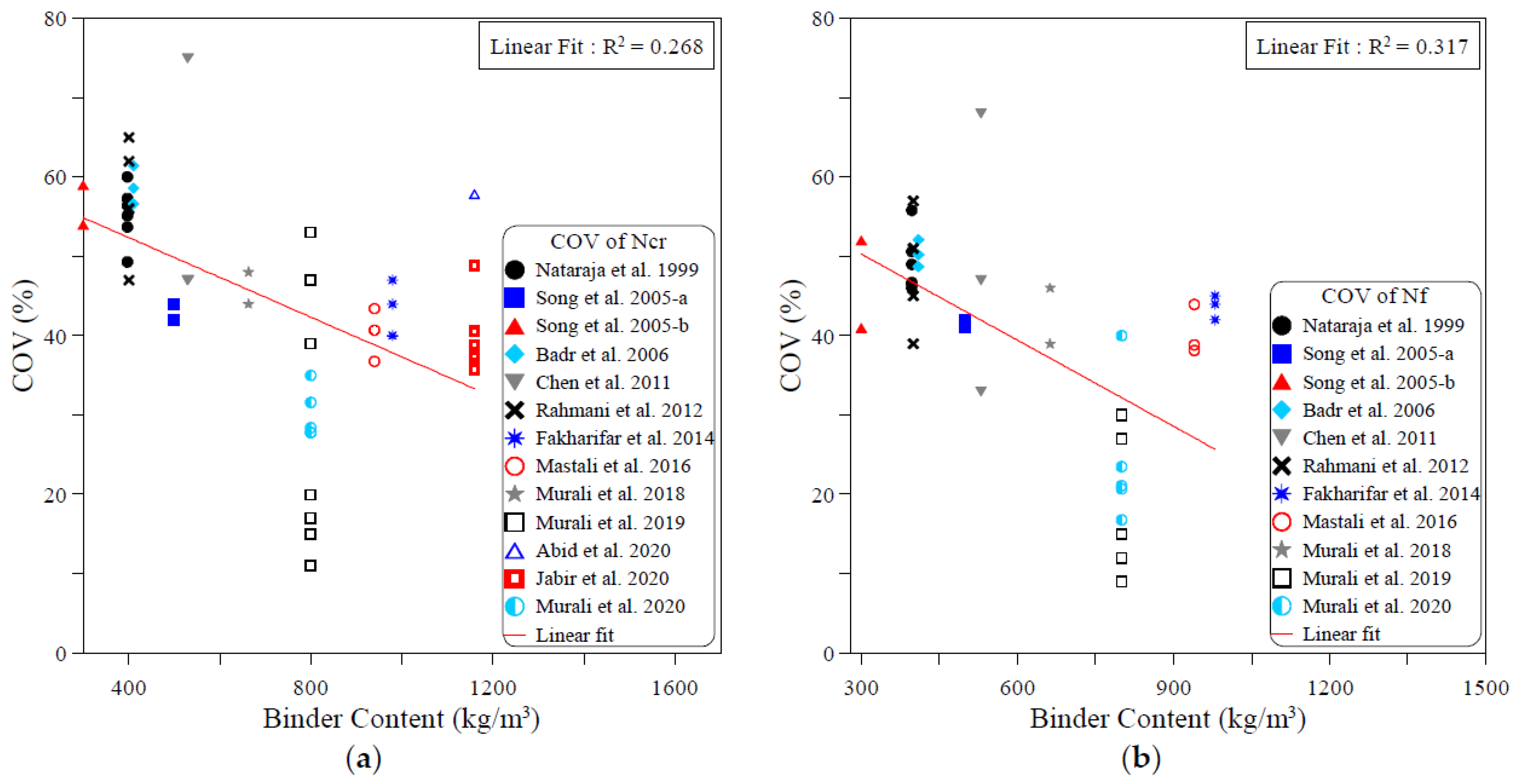

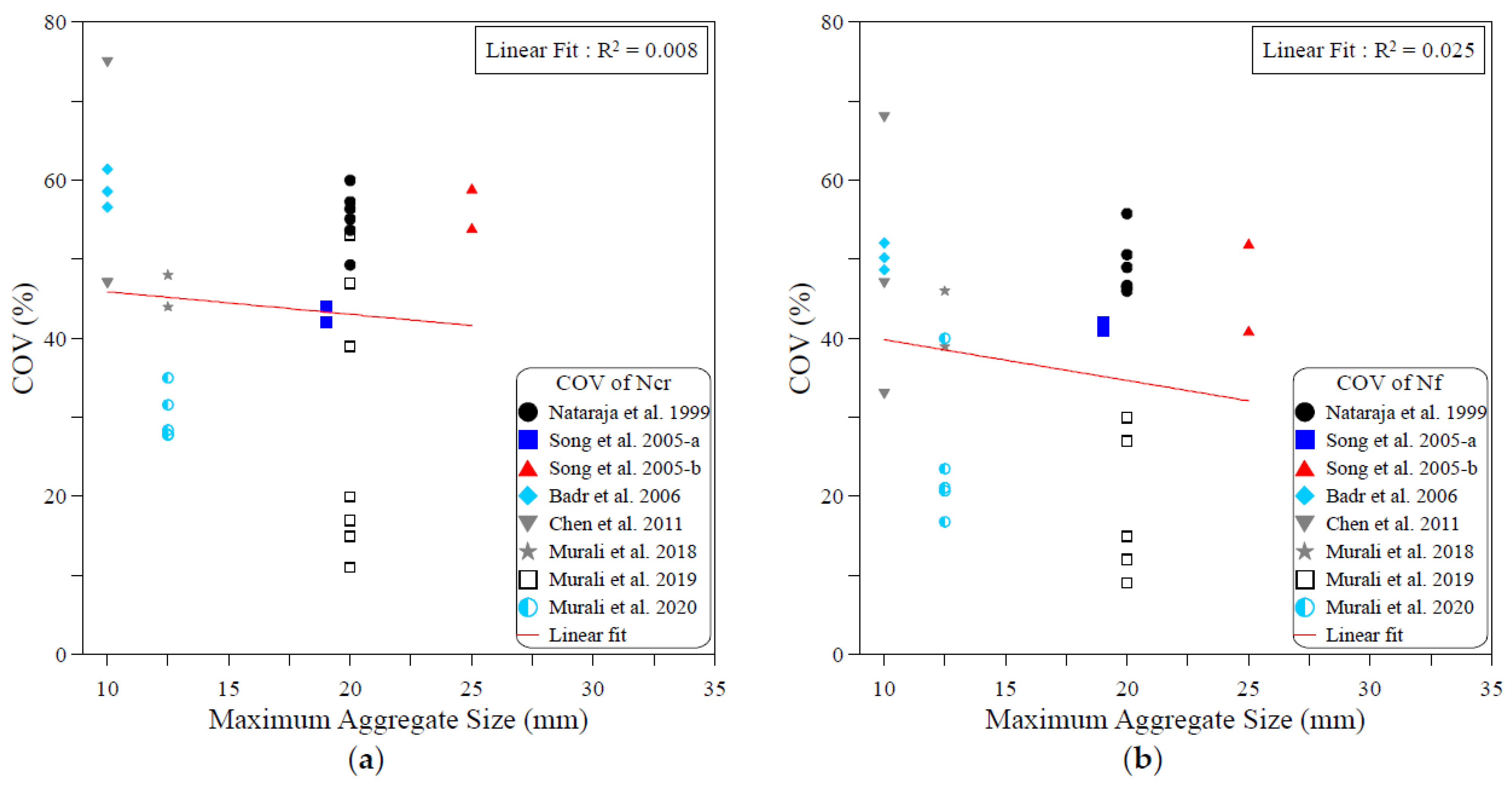

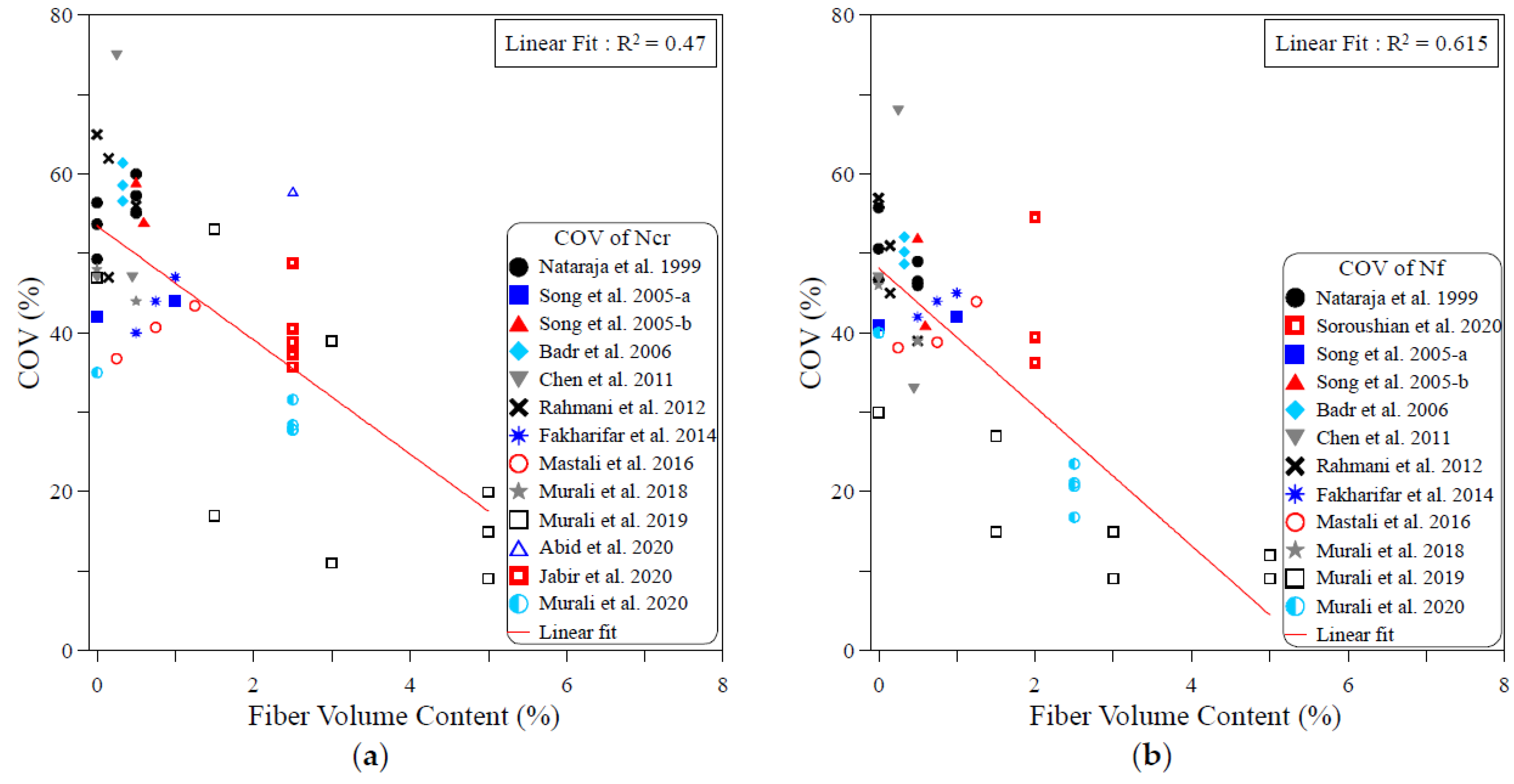
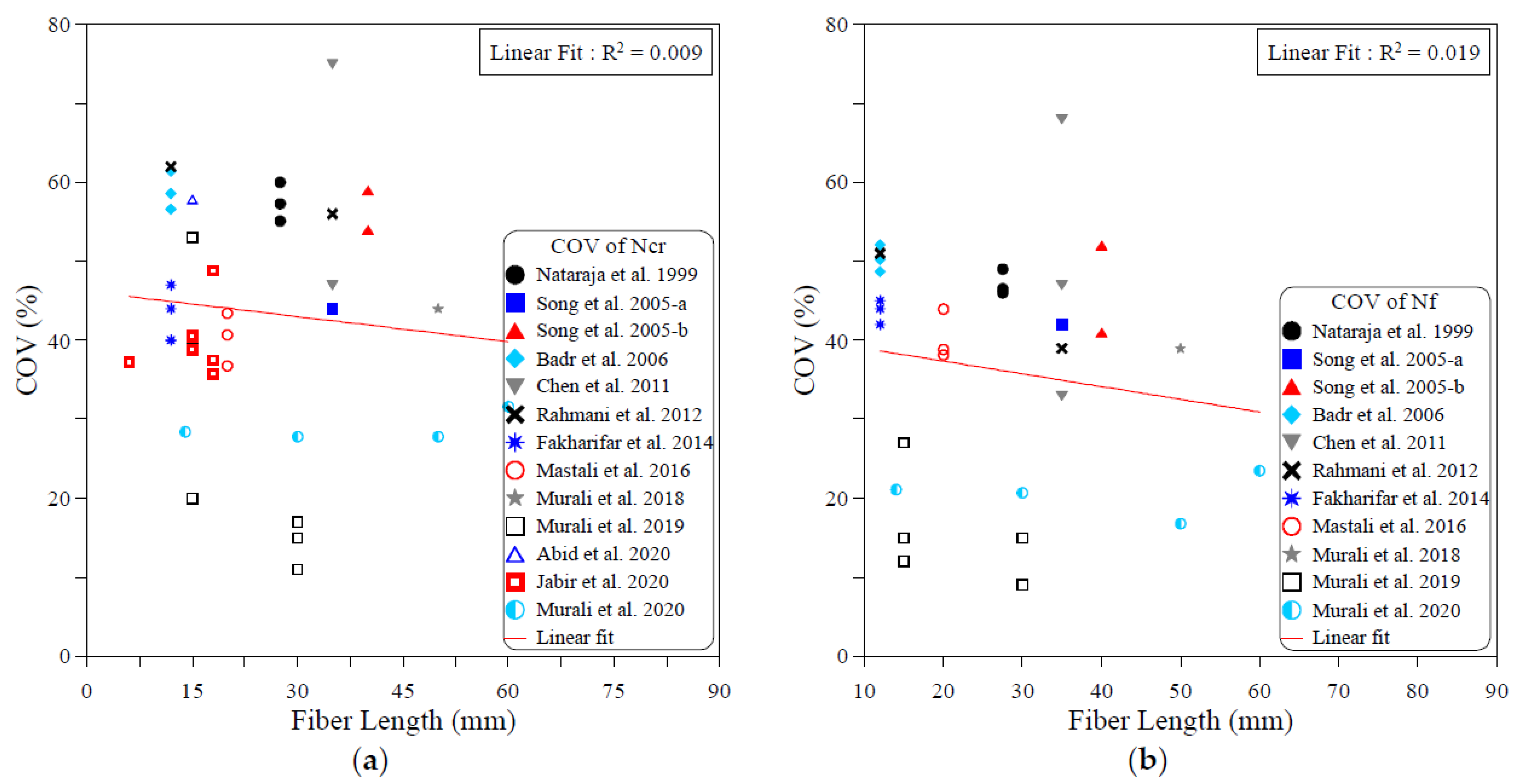

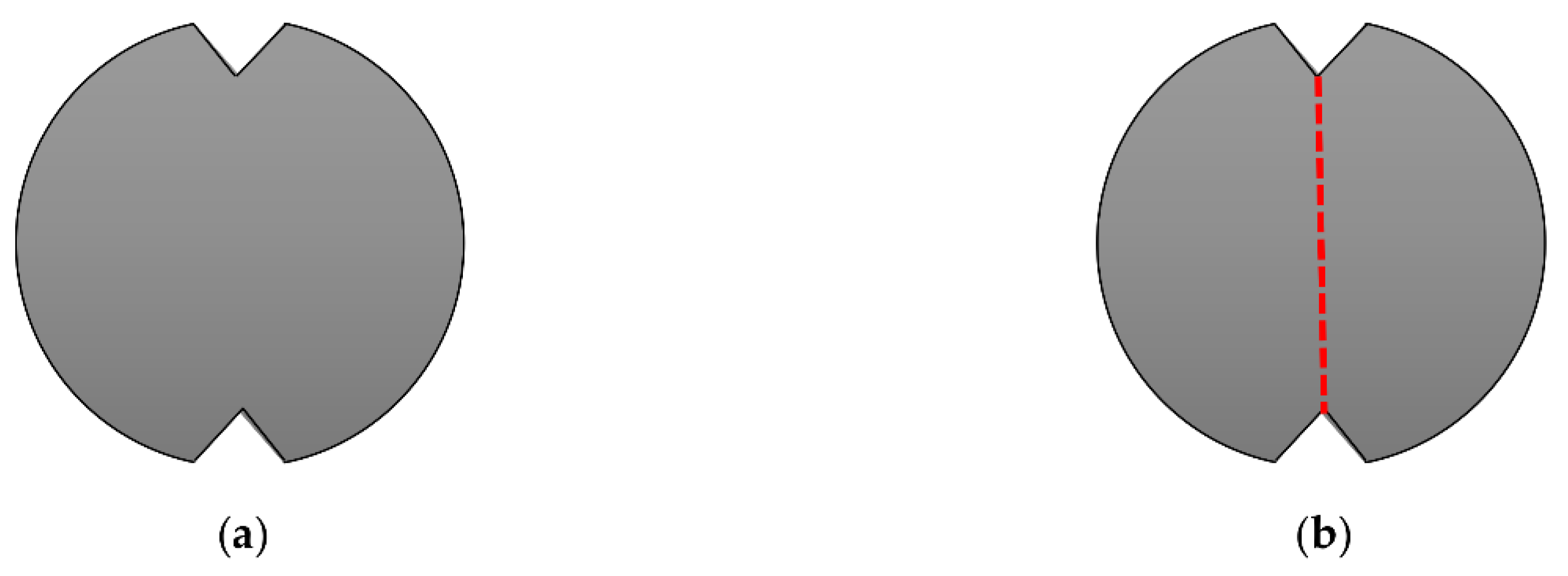

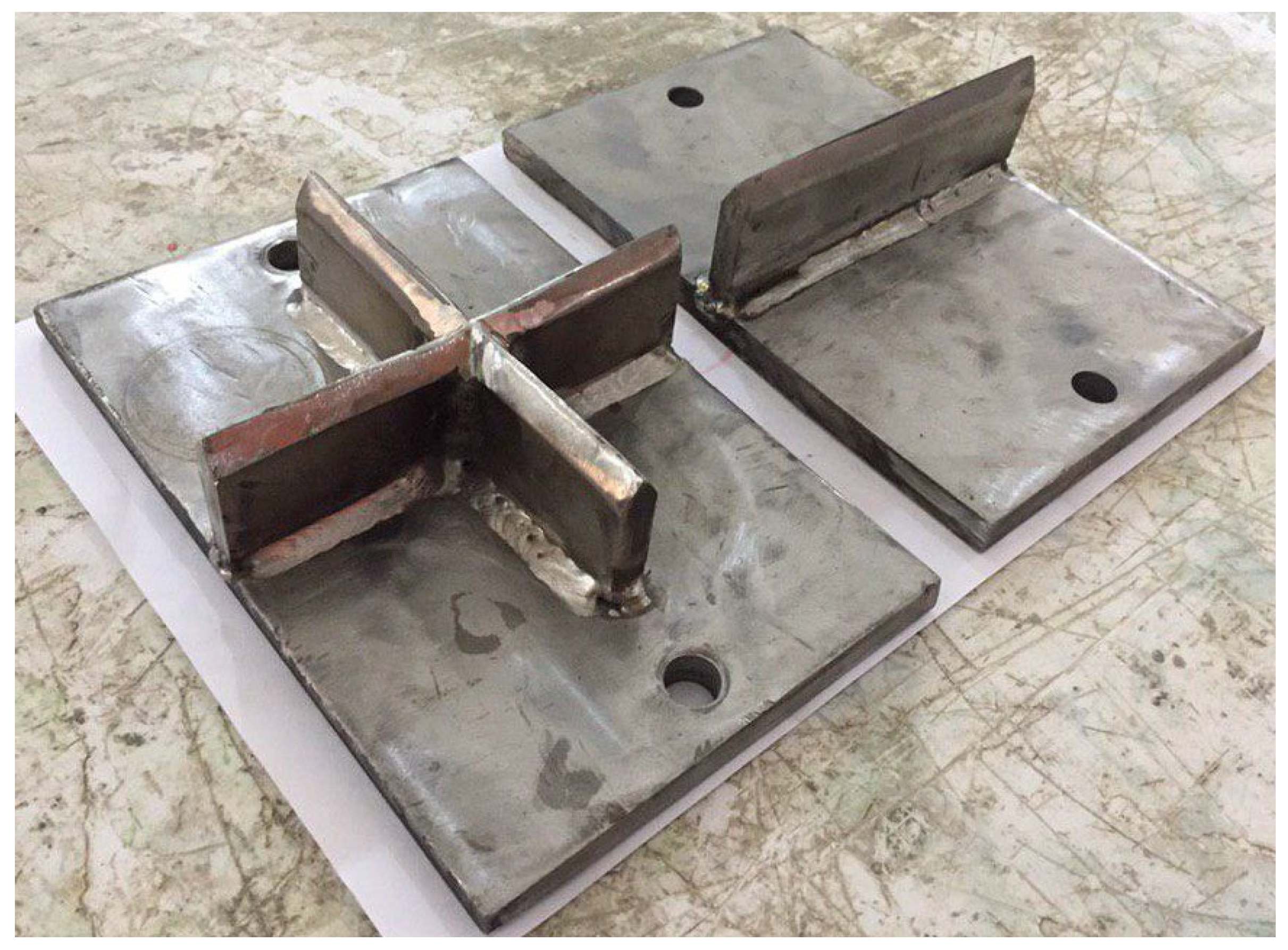
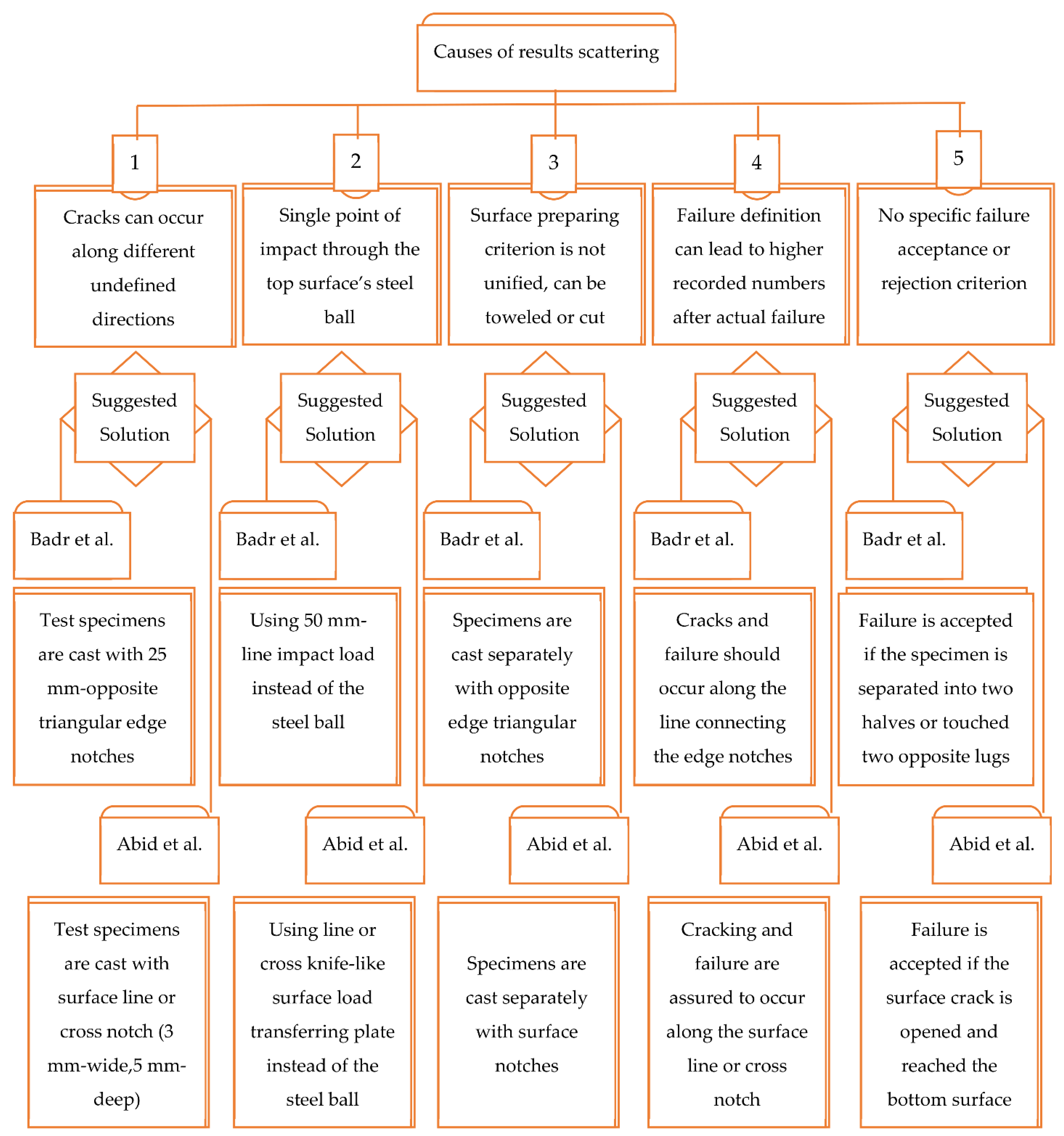
Publisher’s Note: MDPI stays neutral with regard to jurisdictional claims in published maps and institutional affiliations. |
© 2022 by the authors. Licensee MDPI, Basel, Switzerland. This article is an open access article distributed under the terms and conditions of the Creative Commons Attribution (CC BY) license (https://creativecommons.org/licenses/by/4.0/).
Share and Cite
Abid, S.R.; Murali, G.; Ahmad, J.; Al-Ghasham, T.S.; Vatin, N.I. Repeated Drop-Weight Impact Testing of Fibrous Concrete: State-Of-The-Art Literature Review, Analysis of Results Variation and Test Improvement Suggestions. Materials 2022, 15, 3948. https://doi.org/10.3390/ma15113948
Abid SR, Murali G, Ahmad J, Al-Ghasham TS, Vatin NI. Repeated Drop-Weight Impact Testing of Fibrous Concrete: State-Of-The-Art Literature Review, Analysis of Results Variation and Test Improvement Suggestions. Materials. 2022; 15(11):3948. https://doi.org/10.3390/ma15113948
Chicago/Turabian StyleAbid, Sallal R., Gunasekaran Murali, Jawad Ahmad, Thaar S. Al-Ghasham, and Nikolai Ivanovich Vatin. 2022. "Repeated Drop-Weight Impact Testing of Fibrous Concrete: State-Of-The-Art Literature Review, Analysis of Results Variation and Test Improvement Suggestions" Materials 15, no. 11: 3948. https://doi.org/10.3390/ma15113948
APA StyleAbid, S. R., Murali, G., Ahmad, J., Al-Ghasham, T. S., & Vatin, N. I. (2022). Repeated Drop-Weight Impact Testing of Fibrous Concrete: State-Of-The-Art Literature Review, Analysis of Results Variation and Test Improvement Suggestions. Materials, 15(11), 3948. https://doi.org/10.3390/ma15113948










